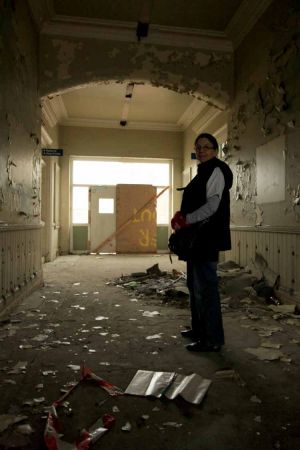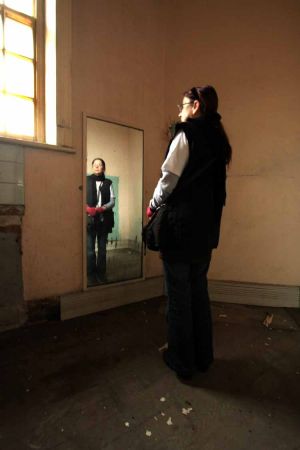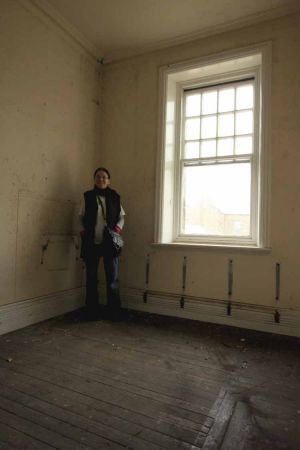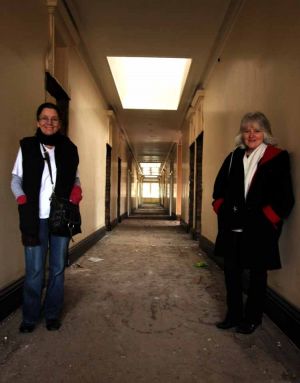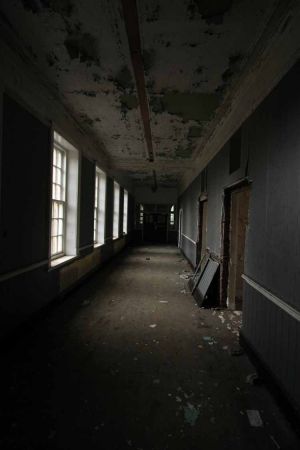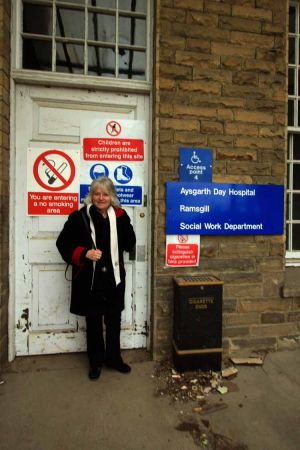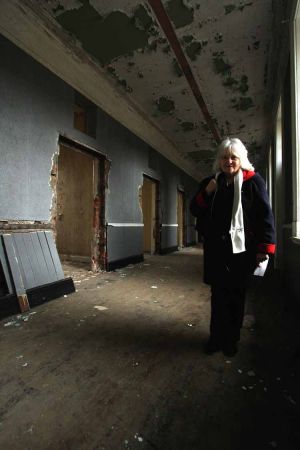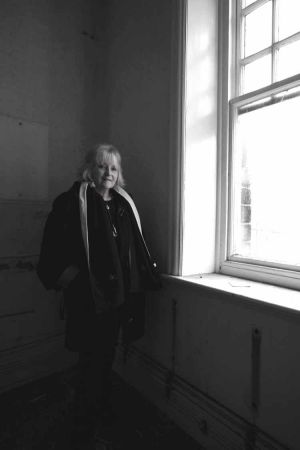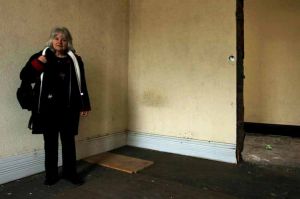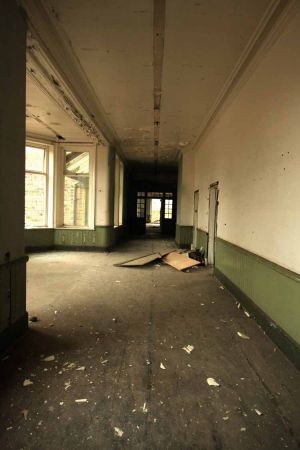Thank you very much to nurse Carol Badham for writing this wonderful piece recalling her High Royds experience.
It was 1962.
I was an immature seventeen year old, brought up by parents with Victorian values, wanting to join my two friends who were working in Menston. Eventually I was allowed to apply for a nursing post. My aunt from Leeds was made responsible for me, giving regular feedback to my parents.
I met my aunt at the main drive. We walked up. It seemed never ending. Then, in front of us, we saw this massive, Victorian building; it was quite overwhelming. I felt scared it seemed so eerie.
Matron met us at the front doors of the main building. I was ushered into the boardroom. Matron sat at one end of the very long table, me at the other. She produced the examination papers and gave me a time limit to complete them. She stayed the whole time. It was nerve racking!
Then I was taken to the residence for nurses and a doctor came in to do a physical examination on me. She took a urine test and bloods, then we were back to the board room for my exam results. Matron said that I had got excellent grades and providing the physical was ok, she would send a letter with starting dates. I was so green I said that I wanted to be a nursing assistant, but she convinced me that I should train and that the exam was equivalent to university entrance. She said that policemen and firemen take the same entrance exam.
On my return to start work, I was taken to the sewing room to be measured for my uniform, then on to the nurses’ home.
My room was small, with a single bed, a small wardrobe and bureau and from the window, there was a view of the hospital clock. No excuse to be late for duty. The room was immaculate, with dark wooden floorboards and a rug in the middle of the room. Board was £7 a week, which left me with £2.99. I sent £2 home to help the family as was expected.
In 1962, the hospital had 2,200 beds and a great shortage of staff. The wards had 90 beds, with little space in between them. There was just room for a locker width and no privacy for patients.
When I was shown into Whernside ward, I got the shock of my life.
I was horrified to see a woman sat up in bed, with pure white hair, stood up on end, her arms outstretched. She was screaming her head off, probably because the bed had a cot side on it. She must have felt restricted and frustrated. I was shocked and shaken by this experience.
Wards and Routines
There were 90beds on some wards with a ward sister and usually two nursing assistants, a student when available. Large open fires had to be cleaned out; emptying the ashes and resetting the fire with lighter and coal, the a large fireguard was locked in place.
There was a hand over period between night and day staff, to discuss patient’s physical and mental states and their treatments.
Wash tanks were filled up with water and towels, clean nightgowns and drawsheets.
Each patient had a material bag with clean clothes in for each day; nurses filled them each night and they hung on hooks in the bathroom.
Patients were sat up on the bed, their legs brought up and helped onto the commode and positioned at the side of the bed. Thy were then washed, face, hands, breasts, arms and bottoms. Clean clothes were then put on and they were wheeled into the day room. Chairs had trays on the front that stopped patients getting up and falling. It frustrated them and often they screamed and shouted.
When all beds were made, Sister brought out the medication, which helped calm patients down. Only the sister had ward keys. A great big bunch for all the cupboards on the ward as well as medicine.
Bed patients often had bed sores, because there was not enough staff to move them on a regular basis. They were given a massage with carbolic soap. This tightened the skin and helped it to become tough and not break down as easy. There were diabetics to have injections each morning, dressings, psychotropic injections to administer etc.
Next it was “turning out time”. A large screen unfolded with green material in each section was placed across the front ward door to stop porters and others entering the ward. The only bit of privacy. Each patient was toileted and changed if need be.
At dinner time, the Ward Sister served the meal out and nurses were busy feeding patients who required feeding.
Daily routines were hard due to the shortage of staff. Adverts went out to Spain and China to recruit nurses for training.
Knives, forks and spoons were all checked and locked away in a box with a brass lock on the front and a brass handle on the top. More able patients helped with the ward chores, the floor polishing, using large bumpers, they swung from side to side with a certain rhythm. They helped on some wards, setting tables, washing up and making trays of tea for staff arriving on duty.
Matron and the superintendent visited together on a weekly basis. Matron visited at other times. She would measure the turn back over the counterpane. If it was more than twelve inches, it had to be made again to her specification. She would even check that the sweeping brushes were clean, if not she would run a bath and put them in and clean them. She insisted that lockers were cleaned out on a regular basis and after a death, the bed had to be disinfected and if it was a sunny day, the bed was put out on the veranda to be sterilised by the sun. The wards were well ventilated and aired. If nurses had any spare time they were encouraged to converse with patients.
At bedtime, patients wore nightgowns with a slit down the back so that their bottoms were on the draw sheet and the nightgown and tucked under to reduce the patients wetting the gowns.
Teeth were collected in pots on a large white enamel tray and put in the bathroom to be cleaned for the next day. Each evening the dirty clothes were sorted out in the laundry and clean clothes put in the bags and hung up for the next morning.
E.C.T. took place on some wards which were Aysgarth, Kingsdale House, Linton House and Escroft Clinic before the treatment unit on Escroft was set up. On the wards each bed had a green screen between when treatment took place. Doctor and nurses attended when the anaesthetic was given, convulsions were quite vigorous, so nurses had to hold patients down by their shoulders and knees, so that no bones got broken. Later with more modern drugs, the convulsion became quite mild. Escroft clinic had a ward for E.C.T and also a sick ward for recently admitted patients who were potentially suicidal. A nurse had to be in the sick room all the time, if she needed to leave for any reason, another nurse took over.
Aysgarth ward had a padded cell and seclusion rooms, as did other wards such as Birkdale and Ingleborough and others. The sister on Aysgarth told me that prior to the sixties, Nurses actually lived on the ward and slept in one of the seclusion rooms, they were nurses bedrooms then before they had nurses residences.
Minor operations and teeth extractions were done in the operating theatre, sometimes when patients had E.C.T. whilst under anaesthetic ganglions would be removed. Later, escort nurses would escort patients to general hospitals because the public feared mental illness and sometimes patients had psychotic episodes or disturbed behaviour when not allowed their psychotropic medications.
Nurse Training
Was a twelve week induction course and consisted of anatomy, physiology, health and hygiene. Followed after with one day a week in training school. The rest of the time was spent on the wards to link training, learning and experience. Because of a shortage of staff, more often than not, third year students were in charge of wards.
In the training school, the senior tutor would read articles from the nursing times. I remember thinking I could do this in my own time as I always bought that magazine! We had training in tray and trolley setting as in the sixties we did sterile procedures for example gastric lavage, paracentesis abdominis, packed blood cells, saline drips, insulin therapy and had to sterilise syringes used to give Paraldehyde as it would melt plastic syringes.
I worked twelve months on the wards because I was only seventeen and you had to be eighteen to go into the training school.
What good experience that twelve months was for me. I saw some horrible cases. Gas gangrene that caused tissue to die and decay; it became black and one patient lost some toes. It was awful having to touch them, it made me cringe. We had to burn incense cones to take the horrible smell away.
One lady had her jaw exposed through her face, she had no flesh. I knocked on the sister’s office and told her that the lady needed morphine. Take into consideration that I knew nothing. I was naïve but instinct told me that she needed pain relief. This big, bombastic Sister shouted to get out of the office, that she was in charge and that she would not be told by a junior nurse what her patients needed! When the doctor next visited, I noticed that the patient had been prescribed some morphine to be crushed and drawn up into a syringe to squirt into the jaw to give pain relief. So I felt good that speaking up, did some good for that patient.
After training of three years I became a staff nurse. I was invited to apply for a sister’s post and worked two years as relief sister working on all the wards – a fantastic experience! Then the Kanner Unit for children was advertised; I did not apply. Matron came to my house and asked me to go for the interview. Following this I left to work at another hospital in 1972.
When I returned to High Royds in 1979, I worked on Ennerdale Day Unit. Mixed male and female that attended each day. We had a library area, arts and crafts and made soft toys we sold to but a mini bus. When I passed my test in the mini bus we started taking patients into the community. We had days out in the Yorkshire Dales and visits to Theatres and Craft Fairs.
Patients that had been incontinent of urine and sat rocking on the ward, suddenly began to changetheir behaviour. They were taking notice of the outside world which changed their institutional behaviour patterns. They acted in a particular way on the ward because they followed the behaviour of other patients.
Nurse Managers had taken over from the matrons, and Leeds Trust from the Health Authorities. Many changes took place breaking down the stigma of mental illness and mental hospitals. Interagency work took over. Community psychiatric nurses, housing managers, community police, social workers, district nurses, home care workers and others had multidisciplinary meetings to provide the best possible patient care. General Hospitals started providing twenty eight day after care, and liaised more than with the psychiatric hospitals.. Occupational Therapists provided home assessments providing aids to help patients at home. Community Psychiatric Nurses visited patients that had been discharged to the community, providing treatments such as Anxiety Management, Bereavement Counselling, administration of drugs and giving depot injections, and many more tasks including teaching to other agencies and Day Centres and Health Centres. Each week a meeting took plsce with the psychologist, psychiatrist, psychiatric nurses and social workers to sort out the best skilled person for each patient referred by their General Practitioner. Student Doctors, Health Visitors, District Nurses and other agencies started having a teaching day going into the community with the community psychiatric nurse and being taught about mental health conditions, breaking down stigmas and barriers and being able to give advice to whoever needed it. Also counselling the families and helping them to understand mental illness and how to cope in difficult situations. Families were put in touch with whichever agency could provide the best possible care.
I became a Community Psychiatric Nurse in 1983 till 2000 the role was blurred overlapping with other agencies. We had a weekly clinic for regular follow up of patients and familt relatives were interviewed by the psychiatrist and the appropriate medication prescribed. This meeting took place in the community at the health centre
Carol Badham
——————————————————————————–
The Nurses Return
The starched uniforms and the patients may be long gone, but just for a while, the wards came to life again as Carol and Barbara, two former nurses, shared their reminiscences of as we revisited the empty asylum.
Perhaps they too had never before wandered these wards at such a leisurely pace, no longer rushing around with the urgency and demands of their nursing days. The visit gave an opportunity for reflection, and resurrected some long forgotten memories.
I am very grateful to them both for their unique and valuable contribution to this collection.
All content copyright protected.
